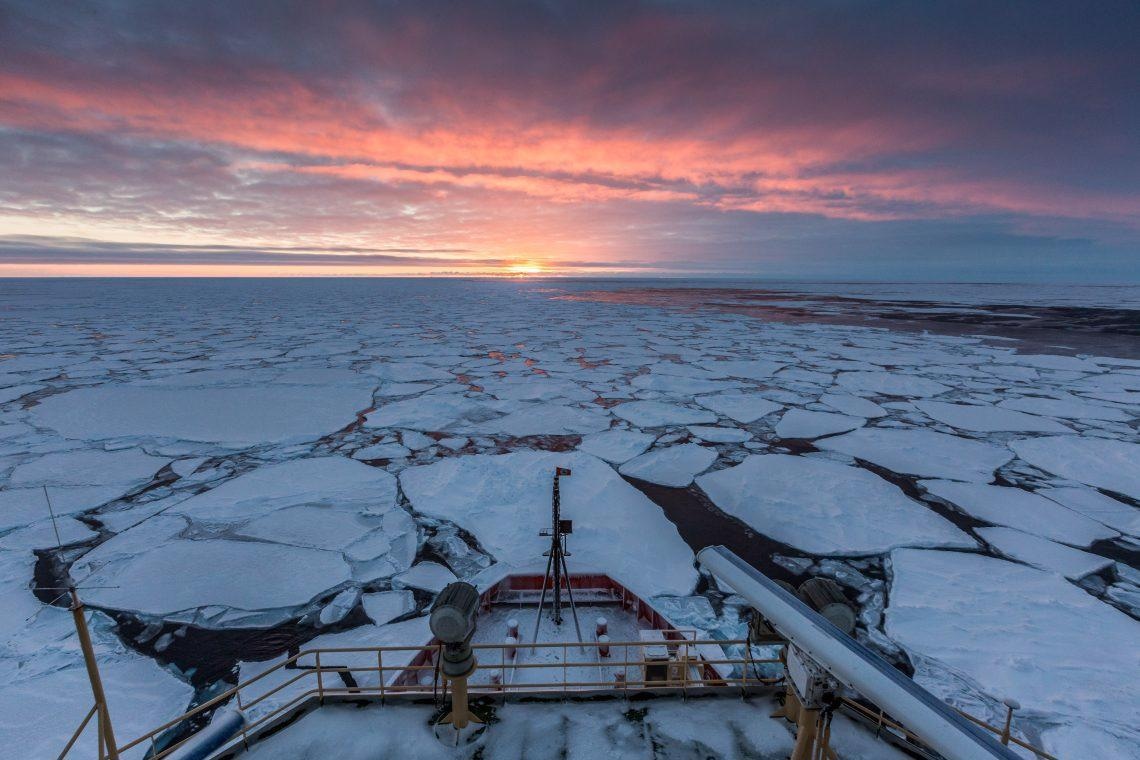The ice cover surrounding Antarctica in the Southern Hemisphere slowly expands between March and October every year. During this period, the entire ice area grows by six times to become bigger than Russia. The sea ice subsequently retreats at a quicker pace, most intensely in December, when Antarctica is under constant daylight.
 A research vessel in Antarctica on June 3, 2017, the first day researchers saw the sun rise above the horizon after weeks of polar darkness. New research shows that solar radiation drives the relatively fast annual retreat of sea ice around Antarctica at the end of each calendar year. Image Credit: Ben Adkison
A research vessel in Antarctica on June 3, 2017, the first day researchers saw the sun rise above the horizon after weeks of polar darkness. New research shows that solar radiation drives the relatively fast annual retreat of sea ice around Antarctica at the end of each calendar year. Image Credit: Ben Adkison
A new study directed by the University of Washington (UW) explains the reason for the ice retreating so rapidly: in contrast to other facets of its behavior, Antarctic sea ice is merely following basic rules of physics.
The study appeared in the March 28th issue of Nature Geoscience.
In spite of the puzzling longer-term trends and the large year-to-year variations in Antarctic sea ice, the seasonal cycle is really consistent, always showing this fast retreat relative to slow growth. Given how complex our climate system is, I was surprised that the rapid seasonal retreat of Antarctic sea ice could be explained with such a simple mechanism.
Lettie Roach, Study Lead Author and Postdoctoral Researcher, University of Washington
Lettie Roach is currently a research scientist at Columbia University and NASA.
Earlier studies examined whether warm ocean waters or wind patterns might be the reason behind the asymmetry in Antarctica’s periodic sea ice cycle. But the new research reveals that similar to a hot summer day reaching its highest scorching conditions in the late afternoon, an Antarctic summer reaches its highest melting power in midsummer, speeding up warming and sea ice loss, with slower variations in temperature and sea ice when the solar impact is low during the other months of the year.
The scientists examined worldwide climate models and learned they reproduced the faster retreat of Antarctic sea ice. They then constructed a basic physics-based model to demonstrate that the reason is the periodic pattern of inbound solar radiation.
Close to the North Pole, Arctic ice cover has progressively reduced since the 1970s due to global warming. Antarctic ice cover, however, has vacillated over the past few decades. Scientists continue working to comprehend sea ice near the South Pole and better characterize it in climate models.
I think because we usually expect Antarctic sea ice to be puzzling, previous studies assumed that the rapid seasonal retreat of Antarctic sea ice was also unexpected—in contrast to the Arctic, where the seasons of ice advance and retreat are more similar.
Lettie Roach, Study Lead Author and Postdoctoral Researcher, University of Washington
“Our results show that the seasonal cycle in Antarctic sea ice can be explained using very simple physics. In terms of the seasonal cycle, Antarctic sea ice is behaving as we should expect, and it is the Arctic seasonal cycle that is more mysterious,” Roach added.
The scientists are currently investigating why Arctic sea ice does not follow this pattern, instead growing marginally faster an ananual basis over the Arctic Ocean than it retreats. Since the geography of Antarctica is straightforward, with a polar continent enclosed by ocean, this feature of its sea ice may be more direct, Roach explained.
We know the Southern Ocean plays an important role in Earth’s climate. Being able to explain this key feature of Antarctic sea ice that standard textbooks have had wrong, and showing that the models are reproducing it correctly, is a step toward understanding this system and predicting future changes.
Cecilia Bitz, Study Co-Author and Professor of Atmospheric Sciences, University of Washington
Other co-authors of the study are Edward Blanchard-Wrigglesworth, a UW research assistant professor in atmospheric sciences; Ian Eisenman at Scripps Institution of Oceanography; and Till Wagner at the University of Wisconsin-Madison.
Roach is presently a research scientist with the NASA Goddard Institute for Space Studies. This study received financial support from the National Oceanic and Atmospheric Administration, the National Science Foundation, the U.K.-based Scientific Committee on Antarctic Research.
Journal Reference:
Roach, L. A., et al. (2022) Asymmetry in the seasonal cycle of Antarctic sea ice driven by insolation. Nature Geoscience. doi.org/10.1038/s41561-022-00913-6.